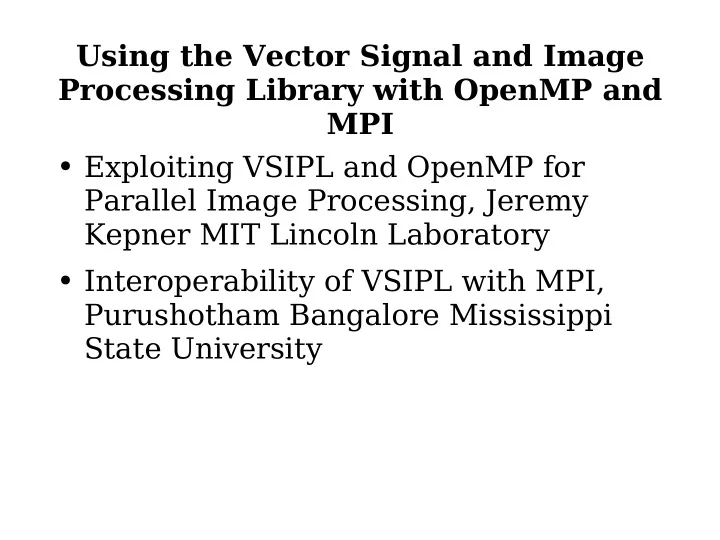

Using the Vector Signal and Image Processing Library with OpenMP and MPI ● Exploiting VSIPL and OpenMP for Parallel Image Processing, Jeremy Kepner MIT Lincoln Laboratory ● Interoperability of VSIPL with MPI, Purushotham Bangalore Mississippi State University
VSIPL ● C API for processing vector, signal or image data. ● Optimized for use with single processor machines. ● Data storage is abstracted, data is accessible only through VSIPL functions.
Interpreted Data Language ● Software package used for scientific data analysis. ● Uses VSIPL. ● Implements an image convolution algorithm.
Image Convolution ● For every pixel in an image, do something based on the value of neighbor pixels and add the new pixel to the result. ● The value of the new pixel is defined by Point Response Functions (one or more). ● For each PRF, every pixel must be evaluated.
Parallelizing Image Convolution with OpenMP in IDL. ● Kepner modified IDL to use OpenMP. ● Convolve each PRF on a different processor and combine the results on a single processor. ● Works well with VSIPL and OpenMP, you do not need direct access to VSIPL data. ● Simple and effective solution.
SGI Origin 2000 ● 64 300MHz MIPS R10000 processors. ● 4 processors/node 1GB/node (16 GB total). ● Non-uniform memory architecture. ● Memory physically distributed over nodes with one system image. ● Effectively a SMP machine.
Results
Interoperability of VSIPL and MPI ● VSIPL data can only be accessed through VSIPL functions. ● Data must be accessible directly to do a MPI send/receive. ● Bangalore gives three possible solutions.
Solution #1 ● Copy data from abstract data types to public data arrays using VSIPL functions. ● Make MPI send and receive calls. ● Copy data into abstract data type using VSIPL functions.
Solution #1 ● Advantages: – Simple – Easy to implement ● Disadvantages: – Overhead – Extra copies of data
Solution #2 ● Use admit and release functionality provided by VSIPL. ● Admit function – locks data into VSIPL ownership, makes data accessible only to VSIPL API. ● Release function – unlocks data into user ownership, makes data accessible only to user activites.
Solution #2 ● Best solution. ● Admit and release functionality was added to VSIPL after David Schwartz suggested it (originally as import and export functions).
Solution #3 ● Create a new API. – New data types – Abstract VSIPL and MPI calls
Solution #3 ● Not a quick solution. ● Feasible for long term uses.
Any Questions?
Recommend
More recommend